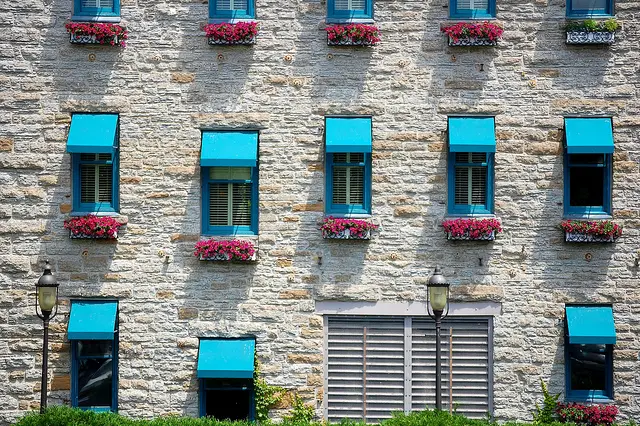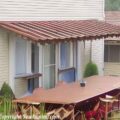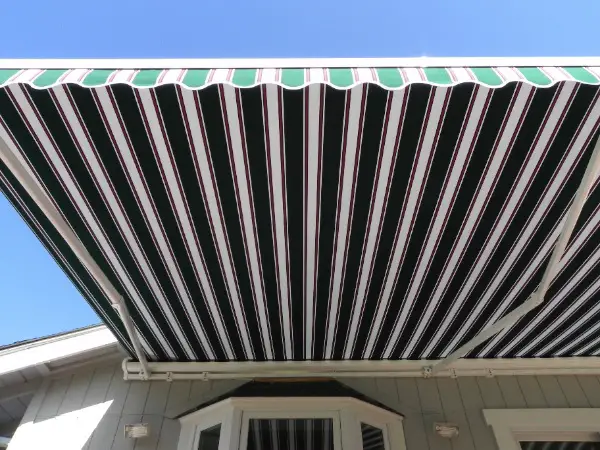Last Updated:July 31, 2025
Can You Paint Awning Fabric?

I had some friends over for a barbecue, and I noticed that our awning was fading from sun damage.
I wondered can you paint awning fabric to make it look new? Yes, you can paint canvas and vinyl awnings, but you will want to use a specific type of paint for each fabric.
You do not want to paint acrylic awnings, and we’ll explain why below with our complete guide. The key for paint selection is to begin a good quality acrylic paint and add the GAC 900 fabric medium.
How do I paint a canvas awning?
You can follow our step-by-step guide below. You will want to use an acrylic paint, and it’s imperative that you mix in a fabric medium so that the paint will remain flexible after it dries, and we prefer GAC900. We first learned of this solvent from a discussion with the paint expert at a special effects company, and we’ve never had a single reader reach out to complain that it didn’t work for them. It’s possible to paint the awning with using the fabric medium, but it can lead to cracks so don’t recommend that unless you’re doing the smallest of touch ups.
How do I paint a vinyl awning?
Vynil awnings pose two unique challenges that differ from canvas. The chemical formula for vynil is (C2H3Cl)n. It is a form of plastic which means that many solutions like paint, gloss, and dyes simply won’t stick to it. You need to use something that will naturally adhere to the durable PVC material. The second challenge of painting a vinyl awning is that when the paint dries, it can lead to cracking. This can lead to tears and holes in the fabric. To get around this, you need to include some form of fabric medium mixed in with the paint. If you’d prefer not to work with epoxy paint, the next best alternative would be the fortified acrylic paint we suggested for canvas. It doesn’t hold to vinyl as well so it won’t last as long, but it is an option to create a face lift that will last a season.
Step-by-Step Guide to Painting an Awning
- Clean your awning. If you’re not sure, we’ve written a complete guide to awning cleaning.
- Let the fabric fully 100% dry.
-
Remove the Fabric from the frame. You can paint it in place; however, it will require being on a ladder. Many homeowners prefer to do their painting on the ground. - Mix the paint with the Fabric Medium listed above.
- Apply the paint – You will want to use a standard paintbrush and apply the coloring in a liberal manner.
- Allow it to dry for 24 hours before attaching to frame (if you took it down)
What color should i paint my awnings?
When deciding to paint your awning, you need to consider a couple factors. If you’re painting your awning the SAME color, it’s important to get a close match. You may want to buy a small test bottle first and try the underside of the awning to see how the paint will look when it’s dry. This is especially true if you’re only doing a small touch up. It’ less important if you are doing the full awning, and the main goal is to ensure there’s no strange reaction when the new hues are overlayed with the original coloring. If you want to paint your awning DARKER, this is the easiest option. You can normally go with a darker color to cover up faded fabric. Colors like black, crimson, or steel blue are fantastic for refreshing the look of a dated awning fabric. It can be a bit tricky to paint your awning a LIGHTER color. If you’re going with this approach, it may take a couple layers of paint, and we recommend a clear code above the fabric to seal the surface. After the clear coat creates the base, the new layer of the lighter colors will be more vivid and bright. For any option, we strongly recommend testing the outcome on the underside of the fabric. Additionally, a lot of manufacturers will offer small sample size pieces of fabric that you can test paint samples with. The worst case scenario is that you paint the entire fabric something that won’t work after it dries as you’ve now wasted the time and material.
How can I paint an acrylic awning?
You can paint this fabric, and we will share the best options. However, we generally prefer against this. Solution-dyed acrylic fabric such as sumbrella has their pigment set at the time they are created. The threads are the same color throughout because they are extruded into long strands. The awning fabric is then woven into this perfectly pigmented fabric. If you apply paint to this, you are only changing the color of the exterior layer which greatly diminish some of the value from using the acrylic fabric. If you do need to change the color, you can use a latex acrylic paint and follow the step-by-step awning painting guide above.
Can you paint cushions to match awning?
Absolutely. You just need to determine what type of fabric it is, and many times the patio furniture manufacturers will have specific recommendations.
Can you paint metal awnings?
Of course, we have a complete guide to painting metal awnings here.
Do you always apply with a brush or can I just spray it?
We’ve never used spray paint so we’re not qualified to answer this. We prefer a regular bristle brush.
What’s wrong with cheap paint?
Acrylic paint is composed of 3 materials. They are the acrylic which acts as the glue, the pigment that adds the color, and the solvent which evaporates causing the paint to dry. The pigment is the most expensive ingredient, and we’ve seen cheap paints that have 1/10th the pigment as the good quality paints we recommend. Since all the color comes from the pigment, the cheap paint will require multiple coats compared to a single coat of the good paint
How much paint is needed?
One gallon of paint will cover around 350 square feet. A quart of paint should be enough to cover an 8’x10′ awning.
Can I use interior paint on my awning?
We strongly recommend against this. Interior paint dries more rigid which can lead to the fabric creating cracks. It can also lead to tears as the fabric needs to be flexible to move with the wind. Additionally, many types of interior paint are not designed to stand up to rainstorms or heavy water. This can lead to their color fading far more quickly than expected. Finally, the colors will wear unevenly because the top sloped part of the awning will have water that drains off it. Finally, the colors will wear unevenly because the top sloped part of the awning will have water that drains off it. Rain that lands at the top of the awning will roll all the way down to the bottom of the awning. Drops that hit the awning near the bottom will only wear the lower part of the awning, and the sides and valance will get minimal water damage since they are vertical. Awning fabric can look horrible and dated after a single year for rainier areas.
Uh oh, I’ve used interior paint, can I just paint over it?
This solves one of the two problems. Using the exterior paint as an outer coat will stop the uneven wear of colors; however, it will still suffer from the cracking. My best recommendation is to use a paint solvent to remove the interior paint. After you let it fully dry apply a primer with a coat of exterior paint.
Any tips on using acrylic paint?
Acrylic paint dries much faster than other types of paint so I recommend starting with a small area as a test. Once your comfortable with the process then you can move to painting the entire awning.
How long does acrylic paint stay last?
In it’s canister, acrylic paint can last for years. After it is applied, the color will also last for many years. We normally apply a sealant every second year to keep the color from fading or getting washed away from rain. The latter is less important for us as we live in Arizona so rain isn’t something that’s a huge issue for us.
What’s the best paint for high temperatures?
We live in Arizona, and our summer temperatures can get above 115. We haven’t had an issue with high quality exterior paint. My guess is that interior paint would dry out and crack, but we’ve never had an issue using exterior paint.
Can exterior paint freeze?
Yes. Both latex and oil based paints can freeze while in its canister. If your paint freezes, allow it to slowly thaw to a warmer temperature. Don’t try to heat it up, but rather just leave it sealed in its can in a warm room of your home. Eventually it may return to a normal liquid consistency. Some paints are able to be used even after freezing and thawing a few times. You’ll want to test a small area before applying to a whole canvas.
Can you paint canvas awnings?
Yes. You can paint canvas awnings. You will want to ensure the fabric is completely dry and mix the paint you choose with the GAC900 fabric medium. We recommend picking a day that has no rain in the forecast to provide a full day to totally dry. The one caveat to this is that many people prefer to replace their canvas awning fabric instead of painting simply due to cost. Ottertex makes a fantastic waterproof canvas that’s perfect for awning covers for less than $6 per square yard. It’s cut to order and they have 29 colors. We’ve included a link to Otterex Canvas fabrics on Amazon here.
Can exterior paint be used on metal?
Yes. We have an entire article about painting metal for awning frames and support.
Can exterior paint go bad?
Yes. The paint can go bad either because the canister develops a hole causing the paint to dry out or if crystals begin to form from the freezing and thawing process.
Can I mix paints to create specific color like Yellow and Blue to make Green ?
The color of a paint is driven by the pigment and there are two options. The first are true color paints which have 100% of the pigments being that color, and the second are “Hues”. Hue paints are synthetic material created by chemically combining different levels of pigments. Hue paints are often less expensive because their factory can work with its suppliers to create a low cost formula. For most projects, we’re totally fine with hues; however, if you go with this approach never try to mix colors or manufacturers. Mixing hue paints often results in a dingy brown color regardless of what two colors you combine. When in doubt it’s best to buy the final color you want form a single manufacturer.
What’s the best outdoor fabric paint for canvas ?
If you want to paint canvas, we prefer using outdoor house paint because it has the UV blockers to resist fading. It is also designed to function in all weather environments better than many of the fabric paints we reviewed. If you go with a traditional outdoor house paint, it’s imperative that you mix in the GAC900 fabric medium so that it will remain flexible even after the paint fully dries.
Our research process
Our team of editors reviewed 45 types of paint for this guide. We only consider the ones that have stood the test of time. We want them to be produced by companies who have been in business for years.
We see a lot of manufacturers take a short-sited approach by making low quality products, and then just launching the same garbage under a different brand once the customer reviews start coming in. Because we only recommend established companies, we can eliminate many of these risks.
We also look for products that have an active support community, and that meet the residential building codes for most states. Some states like Florida and California have more restrictive building guidelines so going with products that meet those standards mean that should work in most other parts of the country.
Finally, we also look at the technical elements of the products. Our site was established in 2012, and we’ve built up an expertise in the shade and awning space. We know the weights of fabric, the types of metal frame, and understand how to evaluate the gears. We’ve also written extensively on awning repair and maintenance so we can speak to the life expectancy.
After several years in business, we expanded to other products in the patio and backyard space. We live in Arizona, and we’re able to spend most of the year outside.
Finally, if you have any questions, feel free to send us a message on our contact form.







